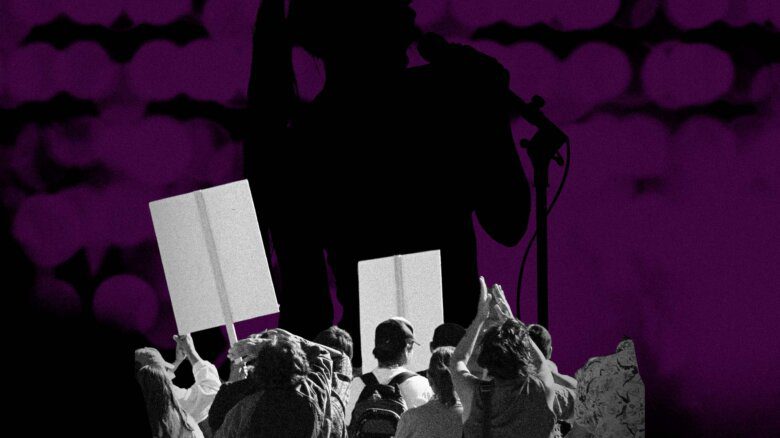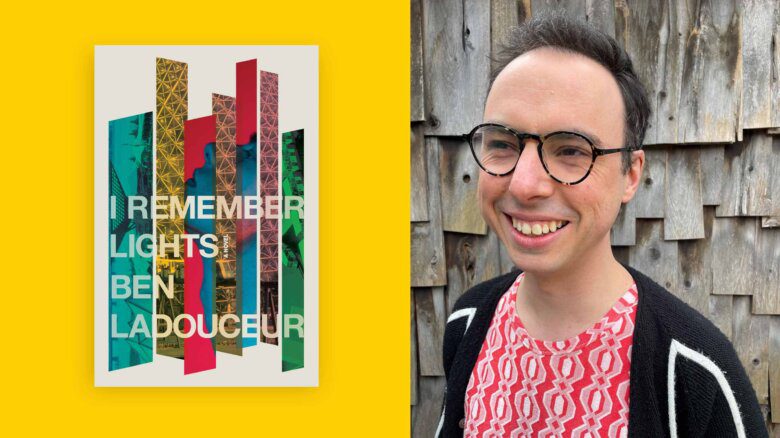This story is part of My Queer Kitchen with Jennifer E. Crawford: Pandemic Edition, a cooking series promoting community, ingenuity and delectability during the time of COVID-19.
I developed this milk and honey cheesecake recipe earlier this year to celebrate the Jewish holiday of Shavuot for the first time. But first, a little story I heard by total chance:
“Oh, I knew your grandfather! I knew him. I knew him. He drove a cab. I didn’t know he had a son. What I do know is that he was a good man, a good man. Now, when he heard the Jewish kids were having a real hard time getting to school—you know, getting bullied and what not. It was the ’50s in Halifax, it was not easy. Before he started work each day, he would go pick each and every one of them up in his cab. All of them. And take them right to the doorstep. He was a mensch.”
A slap on a table with a hearty palm to emphasize the point. Our coffee cups and spoons rattled. My heart did, too.
Collected at a diner over coffee from a man I was casually chatting with as I awaited my dining companion, this is the only anecdote I have about my grandfather, my zayde. He died well before I knew he existed. My dad also died before I learned he was Jewish. Their stories were buried with them. I have a handful of photos—photos of photos, actually; a childhood contained in pixels—on my phone. My grandfather and my dad at the beach, in their ’50s speedos, hugging and eating chips (at least I know where I get this tendency from). On the skating rink, my dad shaped like an overstuffed star in his snowsuit, rosy cheeked. Dressed up in dapper herringbone tweed together outside of huge, handsome wooden doors—to where? Synagogue? I don’t know. But smiling, smiling, smiling. It was the ’50s: Photography was not cheap, and their money was scarce by all accounts. I like to think this means my dad was very loved as a kid, at least for a time.
What does this have to do with cheesecake? Well, I’ve been spending the last few years trying to learn about Jewish life, piecing together my own Jew-ish-ness and connection to Dad, to my grandfather. I read a lot. I take classes. I follow Jewish meme accounts. I try to contribute where I can. Mostly, I feel very incapable in many parts of this learning!
When I feel incompetent, I cook to prove that feeling wrong.
When I feel incompetent, I cook to prove that feeling wrong. We eat really well when I’m on a learning kick. Did Dad find the same comfort in a pillowy challah? Did he ever grate his knuckles by accident when making latkes, too? (Or was it just his drunken stepdad who had bloody knuckles?) How many Shavuot cheesecakes did he get to eat in his Jewish home, before his Protestant mom decided she wanted him back? Did he yearn for brisket while obediently munching her ketchup sandwiches? What about the knuckle sandwiches fed to him by his stepdad? When he beat him so hard he lost his hearing on one side, would matzo ball soup have been enough to soothe Dad’s pain? Will it soothe mine?
Shavuot celebrates the giving of the Torah on Mount Sinai and is a celebration, among other things, of the spring harvest. Group learning is a tradition, and there are Torah study sessions that often run all night. It’s customary to read the Book of Ruth: She converted to Judaism, and is known for gleaning the fields. In the Torah, it was commanded that the corners of fields be left uncut during harvest, so that the poor could glean their own grain for nourishment. I’ve been thinking about these lessons since we celebrated Shavuot at the end of May.
In lieu of leaving the corners of the field uncut, how might we make our harvests available to others? What does this look like for reallocating whatever abundance we might know? If we are fortunate enough to feel the flow of milk and honey, we can pour it into our communities, into GoFundMes, bail funds, reparations. Now is not the time to sit on our dollars like a fearful Scrooge McDuck. And it doesn’t have to be money, because we don’t all have a lot of that. Instead, how might we share our metaphorical cab to protect the persecuted every day?
The abundance and comforts we know are doubled across generations—past and future—when they’re shared.
This is all an incredibly long way of saying: Whether via the harvest from actual fields, e-transfers, a cab or cooking with ghosts, the abundance and comforts we know are doubled across generations—past and future—when they’re shared. If we know financial, physical, emotional safety, we have to acknowledge that it’s not good fortune—it’s at the expense of others, thefts from both past and present. It is our work to pour the milk and honey of those freedoms into the service of a more just future.
I used to wish I could make Jewish delicacies with my dad, healing both of our sore spots with every abundant bite. It took me a long while to realize that was exactly what I have been doing this whole time; sweetness shared to soothe bitter wounds nourishes us all.
Sounds intimidating, right? Wrong. Watch Jennifer E. Crawford create this amazing dessert out of a small number of ingredients in a few easy steps.
Milk and honey cheesecake
Crust
Ingredients
5 cups Sugar Crisp cereal
½ cup butter, melted
Pinch of salt (optional)
Method
- Powder the cereal using a food processor, blender or a good old-fashioned Ziploc bag and a rolling pin. Make sure it’s a very fine grind, but a few big chunks are more than okay!
- Pour in the melted butter—add a pinch of salt, if desired—and stir to combine.
- Press the crumb directly into a 9-inch springform pan. If you want to transfer the cheesecake from the base to a serving platter, line the bottom of the pan with parchment to make the transfer a little easier.
- Refrigerate for at least one hour.
Filling
Ingredients
1 ¼ cup whipping cream
3 bricks (8 oz/225 g each) of cream cheese at room temperature
½ cup white sugar
½ tsp vanilla, or ½ scraped vanilla bean (optional)
Squeeze of lemon juice (optional)
Bubble wrap, rubbed with oil, then dabbed dry with a paper towel
Method
- On high, whip the cream into stiff peaks. Set aside.
- Whip the cream cheese and sugar on med-high until the mixture is smooth and fluffy, and all granules of sugar have dissolved completely. Add vanilla or lemon at this point, and mix until worked through.
- Add whipped cream to the cream cheese mixture. At this point, you can fold it in using a spatula until it’s all evenly incorporated, or use a mixer on the lowest setting until it is uniformly incorporated. You just want to be careful not to deflate the delicate air in the whipped cream—that’s what will give the cheesecake its fluffy texture.
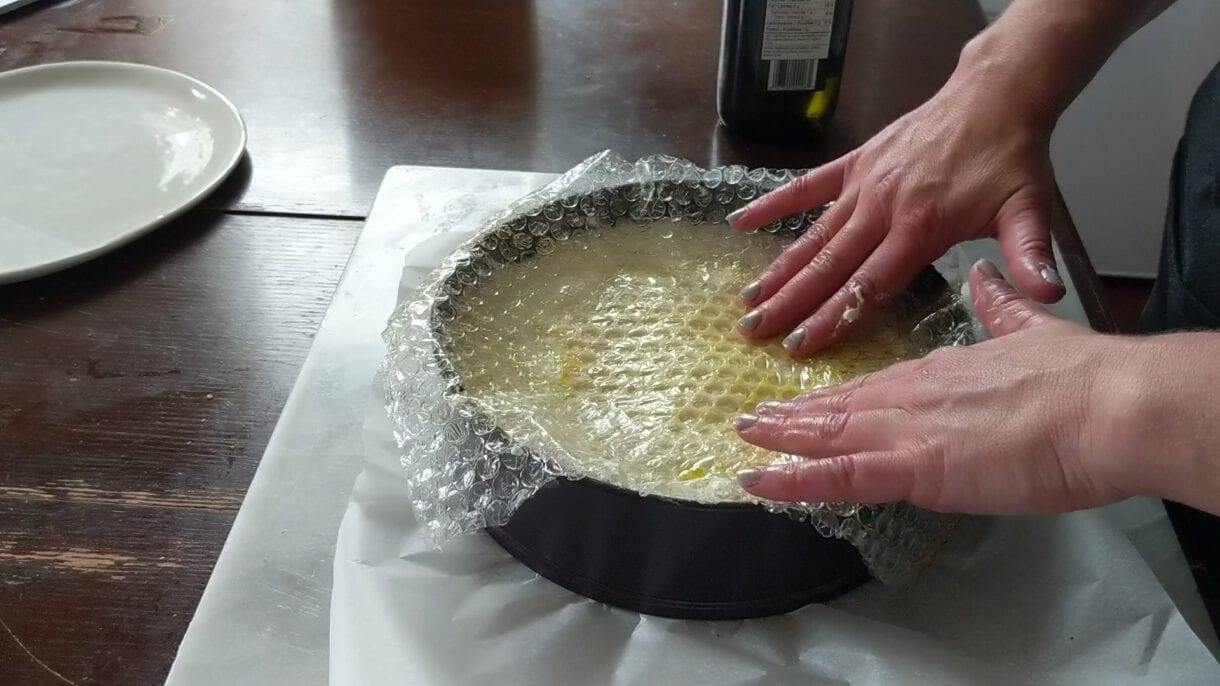
Making the honeycomb pattern. Credit: Jennifer E. Crawford
- Retrieve crust from fridge, and spread mixture evenly across the top.
- Taking your piece of greased bubble wrap and, starting in the middle of the cake, press it firmly into the surface. You should see the filling popping up in between all of the bubbles.
- Refrigerate overnight.
Burnt honey topping
Ingredients
1 cup honey
½ cup very hot water
Pinch of salt (optional)
Method
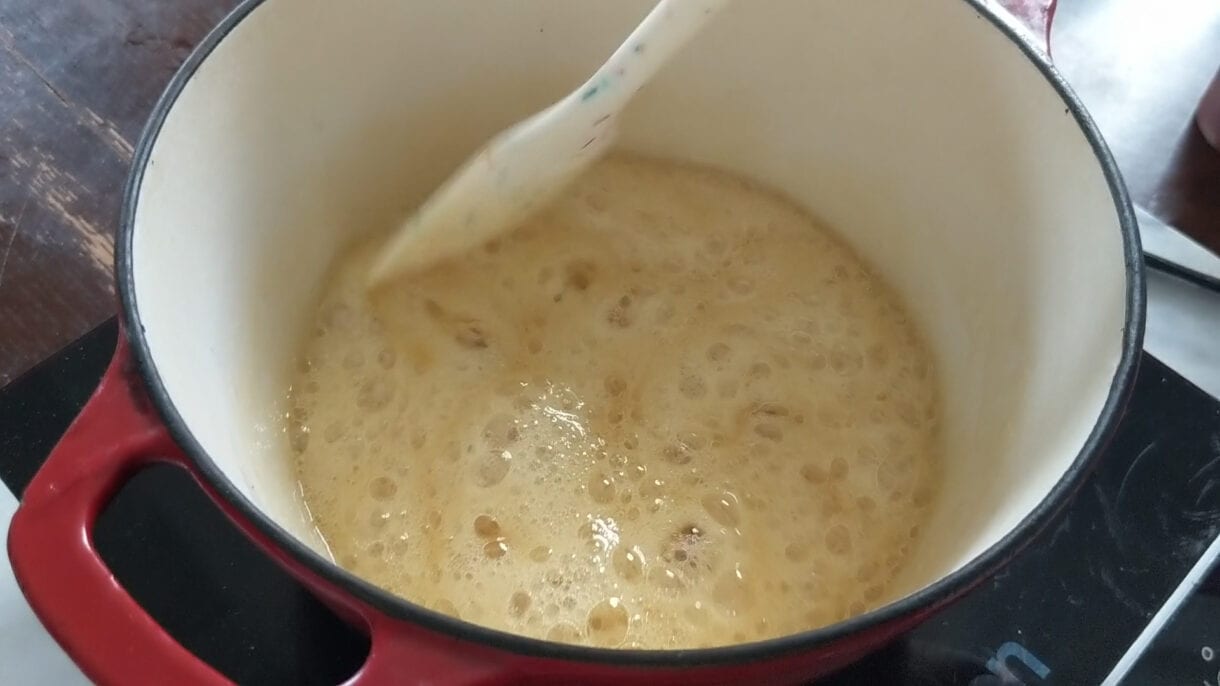
Caramelizing the honey. Credit: Jennifer E. Crawford
- Pour the honey into a high-edged saucepot. (This is one of those processes where you do not want to step away—it all happens very fast at the end!)
- The mixture will heat, steam and aggressively bubble. Using a rubber spatula, stir continually while watching the colour of the honey carefully. Once it has turned the colour of an old copper penny, turn off the heat.
- To prevent the burnt honey from seizing and becoming hard candy as it cools, whisk in a bit of very hot water to keep it “loose.” Depending on the viscosity of your honey, this may take anywhere from ¼ to a ½ cup of water to give it a nice, thick, drippy consistency. Slowly drizzle the hot water into the hot honey, whisking the entire time.
- As the mixture cools over the next hour, check and see how the thickness is doing. If it’s getting too thick, return it to heat and whisk in another few tablespoons of very hot water. It sounds fussy, but it’s actually very forgiving. Too much water? Just cook a bit of it off. Not enough? Add a bit more. You’ll get the hang of it once you see it in action!
- Once it has cooled completely, transfer to a squeeze bottle and refrigerate.
To serve
- Remove the cheesecake from the fridge. Run a knife around the edge of the mold, and release the hinge. If you’re transferring it to a serving plate, you can do that now. (I use a pizza peel and summon every fibre of courage.)
- Peel away the bubble wrap, starting at a corner and going incredibly slowly. So satisfying!
- Only put the honey on once it’s 100 percent cold, and immediately before serving. No-bake cheesecakes are quite delicate, and the weight of the honey will eventually lead it to crack if it’s left to sit on top of the cheesecake for too long in advance. Using the squeeze bottle, pipe the honey into each individual “honeycomb.” Once they are all full, drizzle some extra across the top and near the edges to create an aesthetic of natural irregularity and those drama-drips down the side!
- Garnish with some edible flowers if you have them! Rose petals pair nicely with this, and I’ve used forget-me-nots as well as peony leaves. Just make sure they are unsprayed and clean.
- Drizzle each slice with a bit of the extra honey once you have plated it.
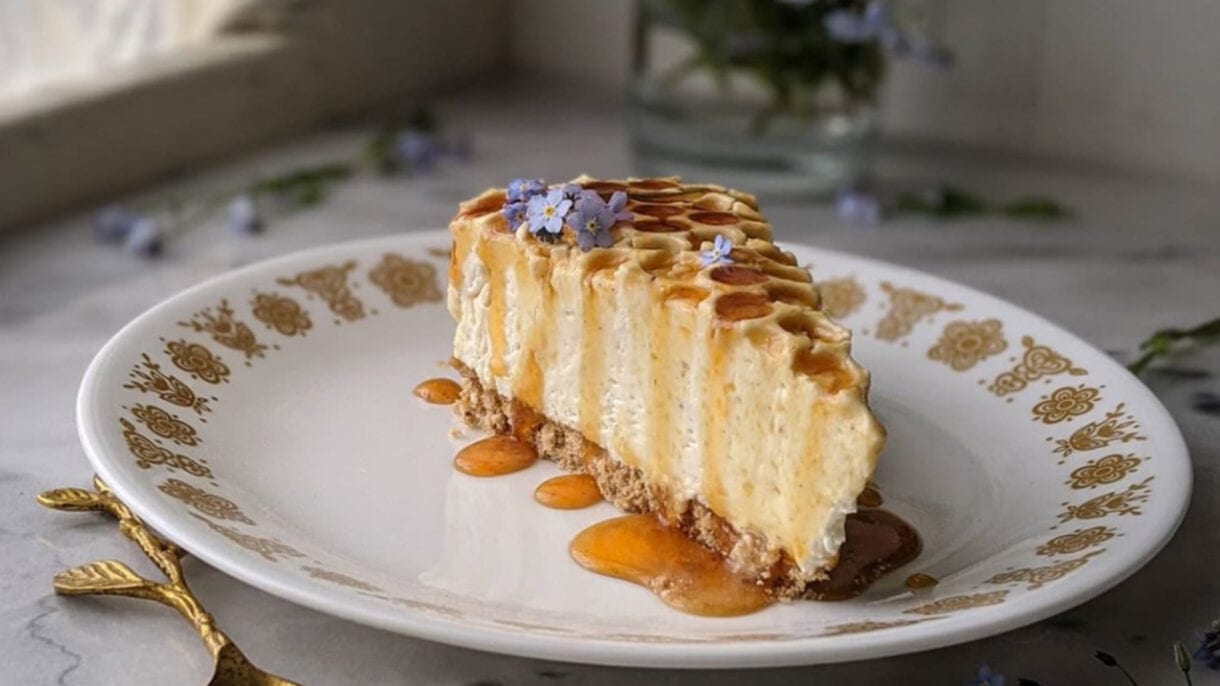
Serve garnished with edible flowers. This version had forget-me-nots. Credit: Jennifer E. Crawford
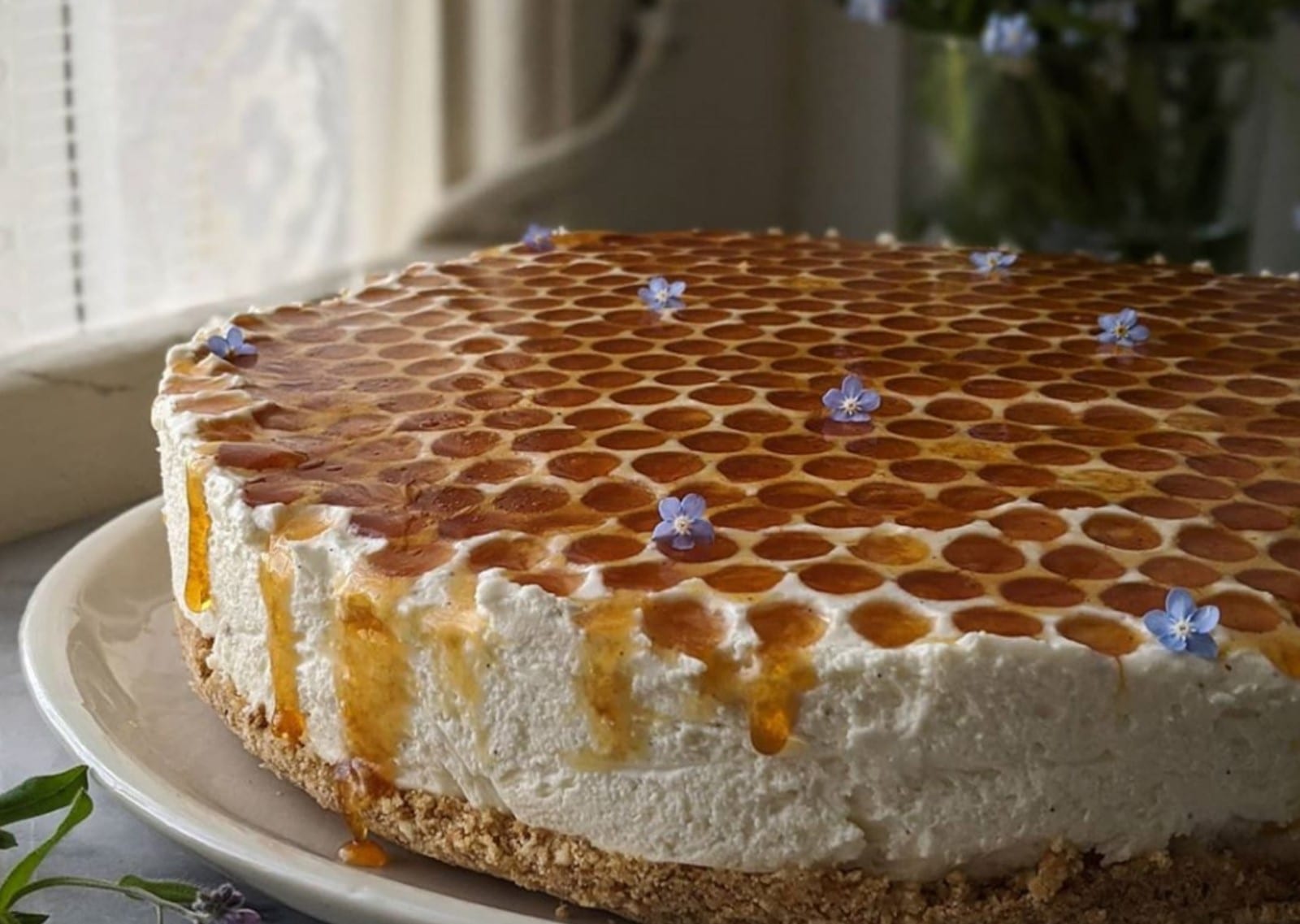

 Why you can trust Xtra
Why you can trust Xtra
